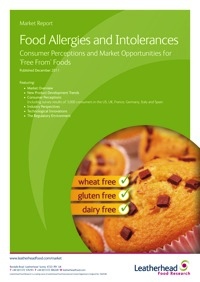
Free-from foods taking off with consumers
By Food in Canada staff
Business Operations Food TrendsConsumers’ perception of the free-from foods category offers “lucrative opportunities” for food processors: report
London, U.K. – There’s a growing category of foods that leaving its mark in North America and Western Europe new research has found.
Leatherhead Food Research, an independent research organization, has found that the free-from food category is appealing to consumers around the world.
Categories
In its new report, Food Allergies and Intolerances: Consumer Perceptions and Market Opportunities for Free From Foods, the largest market is currently the lactose-free and dairy-free category, which had estimated sales of US$3.6 billion in 2010.
Leatherhead says much of the growth in this market is thought to be driven by increased consumption of products such as soy milk.
 In terms of product claims, gluten-free is the fastest growing “suitable for/free from” claim indicating that this market has strong growth potential in upcoming years.
In terms of product claims, gluten-free is the fastest growing “suitable for/free from” claim indicating that this market has strong growth potential in upcoming years.
The market for gluten-free foods in the U.S. and Western Europe was believed to be worth around US$3.5 billion in 2010.
Much of the anticipated growth in the gluten-free sector is linked to “healthy” perceptions of gluten-free foods, particularly amongst groups of consumers who are becoming increasingly aware of their diet, health and well-being and therefore actively seek “suitable for/free from” products without having a diagnosed allergy.
In fact, a consumer survey of 3,000 consumers – published within the Leatherhead report – suggests that American and European consumers perceive the main benefits of “free from” foods to be:
• To maintain a healthy balanced diet
• To help cope with a condition
• To help digestive health
Wider appeal, opportunities
This goes some way to validating the theory that “suitable for/free from” foods have the ability to extend their appeal to a wider audience, moving beyond those consumers with a diagnosed food allergy.
In addition, a high proportion (39 per cent) of the total survey sample (3,000) answered that they had some form of intolerance or sensitivity to food; this suggests that there are lucrative opportunities to be had in this market.
Up until now, says Leatherhead, the market has developed through niche brands with a “free from” USP.
But it’s expected that an increasing number of recognizable household brands will enter the marketplace.
In addition, consumers have come to expect products to be healthy and taste good and are reluctant to trade one off against the other. Ingredient and technology innovations will therefore help to drive this market forward. For example, solutions to improve taste, texture and structure of “free from” foods are in demand.
These factors, combined with the growing interest in this area from retailers, emphasizes the need for “free from” foods to first and foremost be as good as or better than category standard.
Print this page